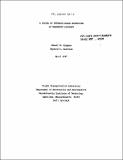| dc.contributor.author | Simpson, R. W. | en_US |
| dc.contributor.author | Ausrotas, Raymond A. | en_US |
| dc.contributor.other | Massachusetts Institute of Technology. Flight Transportation Laboratory | en_US |
| dc.date.accessioned | 2012-01-06T22:09:00Z | |
| dc.date.available | 2012-01-06T22:09:00Z | |
| dc.date.issued | 1987 | en_US |
| dc.identifier | 18486451 | en_US |
| dc.identifier.uri | http://hdl.handle.net/1721.1/68084 | |
| dc.description | April 1987 | en_US |
| dc.description | Includes bibliographical references | en_US |
| dc.description.abstract | Introduction: The safety of enroute operations of aircraft engaged in public transport has been a continuous concern since the early days of air transportation. There are a variety of inflight emergency situations which can create a need to land the aircraft as soon as safely possible: fire in cargo compartments or toilet areas, incapacitated crew members or a medical problem with a passenger, insufficient fuel or oil, failure of one or more engines, or failure of other major aircraft systems such as electrical or cabin pressurization systems. All of these occur frequently enough in public air transport to cause airline operators and airworthiness authorities to consider the time to reach airports suitable for enroute diversion as a factor in planning and approving the operation of any aircraft along its intended route. One of the inflight emergencies which does occur commonly in air transport is the failure or inflight shutdown (IFSD) of an engine. The shutdown of a single engine creates a situation where aircraft are exposed to the risk of an independent failure of a second engine, during the period of the flight to a diversion airport. For a twin-engine transport aircraft, this "double independent failure" case leaves the aircraft with no means of propulsion, and may be considered a catastrophic event since the probability of fatalities in the ensuing forced landing away from an airport is very high. The past five years have seen the introduction of operations by modern twin-engine turbofan transport aircraft on long-haul oceanic routes. These have been dubbed ETOPS (Extended-Range Twin-Engine Operations). This caused a review of the safety of enroute operations by twin-engine aircraft with an emphasis on the situation where there might be an inflight shutdown of one engine. Various airworthiness authorities around the world have established safety regulations to approve ETOPS operations by a specific operator and aircraft-engine combination on "extended range" (ER) routes. In 1986, ICAO amended Annex 6 of its International Standards and Recommended Practices to provide guidance on "extended range operations by aeroplanes with two power-units (ETOPS)" to its contracting states. In June 1985, the FAA issued its Advisory Circular AC 120-42 which "states an acceptable means, but not the only means for obtaining approval under FAR 121.161 for two-engine airplanes to operate over a route that contains a point farther than one hour flying time at the normal one-engine inoperative cruise speed (in still air) from an adequate airport." By the end of 1986, there had been a few years of experience with ETOPS activity by several US and foreign carriers on the North Atlantic routes and in other areas of the world. This study is a review of the current ETOPS situation, carried out for the Transportation Systems Center and the Office of Aviation Safety, FAA, at the request of the FAA Administrator. While the activity of the past five years has focused on extended-range operations of twin-engine transport aircraft, there now seems to be general agreement that some of the regulatory actions should be extended to cover ER operations by all transport aircraft. | en_US |
| dc.format.extent | 48 p | en_US |
| dc.publisher | Cambridge, Mass. : Massachusetts Institute of Technology, Dept. of Aeronautics and Astronautics, Flight Transportation Laboratory, [1987] | en_US |
| dc.relation.ispartofseries | FTL report (Massachusetts Institute of Technology. Flight Transportation Laboratory) ; R87-9 | en_US |
| dc.title | A review of extended-range operations by transport aircraft | en_US |
| dc.title.alternative | Extended-range operations by transport aircraft, A review of | en_US |
| dc.type | Technical Report | en_US |
